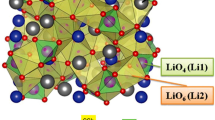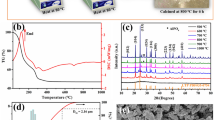Abstract
Because of some drawbacks of the organic electrolytes, such as high toxicity and flammability, inorganic electrolytes have attracted attention regarding applications in all-solid-state rechargeable batteries. However, the fabrication of such electrolytes generally requires high sintering temperatures. To address this issue, in this study, ceramic sheets of Li1.5Al0.5Ge1.5(PO4)3 (LAGP)-based solid electrolyte were prepared using glass, powder, and a glass/powder composite. The use of LAGP and glass-ceramic enabled the prepared sheets to be sintered at a low temperature of 750 °C. The obtained LAGP-based solid electrolytes had the trigonal structure of sodium superionic conductor (NASICON). The LAGP glass/powder composite ceramic sheet (GPCS) exhibited fewer pores and a higher density than the glass-only and powder-only sheets. Owing to its high crystallinity and density, the LAGP_GPCS exhibited total ionic conductivity of 4.52 × 10−4 S/cm, which is exceedingly high compared with that of the other two sheets. This finding confirms that the ionic conductivity of LAGP can be increased by using simple composites. Thus, LAGP_GPCS can improve the efficiency of electric vehicles and smart grid energy storage systems, which rely on high-performance all-solid-state rechargeable batteries.




Similar content being viewed by others
References
Goodenough JB, Kim Y (2010) Challenges for rechargeable Li batteries. Chem Mater 22:587–603
Chen Z, Ren Y, Jansen AN, Lin CK, Weng W, Amine K (2013) New class of nonaqueous electrolytes for long-life and safe lithium-ion batteries. Nat Commun 4:1513
Armand M, Tarascon JM (2008) Building better batteries. Nature 451:652–657
Gachot G, Grugeon S, Armand M, Pilard S, Guenot P, Tarascon JM, Laruelle S (2008) Deciphering the multi-step degradation mechanisms of carbonate-based electrolyte in Li batteries. J Power Sources 178:409–421
Xu W, Wang J, Ding F, Chen X, Nasybulin E, Zhang Y, Zhang JG (2014) Lithium metal anodes for rechargeable batteries. Energy Environ Sci 7:513–537
Zhu Y, He X, Mo Y (2015) Origin of outstanding stability in the lithium solid electrolyte materials: insights from thermodynamic analyses based on first-principles calculations. ACS Appl Mater Interfaces 7:23685–23693
Meesala Y, Jena A, Chang H, Liu RS (2017) Recent advancements in Li-ion conductors for all-solid-state Li-ion batteries. ACS Energy Lett 2:2734–2751
Wu F, Tan G, Chen R, Li L, Xiang J, Zheng Y (2011) Novel solid-state Li/LiFePO4 battery configuration with a ternary nanocomposite electrolyte for practical applications. Adv Mater 23:5081–5085
Xu H, Wang S, Wilson H, Zhao F, Manthiram A (2017) Y-doped NASICON-type LiZr2(PO4)3 solid electrolytes for lithium-metal batteries. Chem Mater 29:7206–7212
Safanama D, Sharma N, Rao RP, Brand HE, Adams S (2016) Structural evolution of NASICON-type Li1+xAlxGe2-x(PO4)3 using in situ synchrotron X-ray powder diffraction. J Mater Chem A 4:7718–7726
Xiong L, Ren Z, Xu Y, Mao S, Lei P, Sun M (2017) LiF assisted synthesis of LiTi2(PO4)3 solid electrolyte with enhanced ionic conductivity. Solid State Ion 309:22–26
Fu J (1997) Fast Li+ ion conducting glass-ceramics in the system Li2O–Al2O3–GeO2–P2O5. Solid State Ion 104:191–194
Leo CJ, Subba Rao GV, Chowdari BVR (2003) Effect of MgO addition on the ionic conductivity of LiGe2 (PO4)3 ceramics. Solid State Ion 159:357–367
Kotobuki M, Koishi M (2015) Sol–gel synthesis of Li1.5Al0.5Ge1.5(PO4)3 solid electrolyte. Ceram Int 41:8562–8567
Mariappan CR, Yada C, Rosciano F, Roling B (2011) Correlation between micro-structural properties and ionic conductivity of Li1.5AlGe1.5(PO4)3 ceramics. J Power Sources 196:6456–6464
Kubanska A, Castro L, Tortet L, Schäf O, Dollé M, Bouchet R (2014) Elaboration of controlled size Li1.5Al0.5Ge1.5(PO4)3 crystallites from glass-ceramics. Solid State Ion 266:44–50
Zhu Y, Wu T, Sun J, Kotobuki M (2020) Highly conductive lithium aluminum germanium phosphate solid electrolyte prepared by sol-gel method and hot-pressing. Solid State Ion 350:115320
Zhang M, Huang Z, Cheng J, Yamamoto O, Imanishi N, Chi B, Pu J, Li J (2014) Solid state lithium ionic conducting thin film Li1.4Al0.4Ge1.6(PO4)3 prepared by tape casting. J Alloys Compd 590:147–152
Thokchom JS, Gupta N, Kumar B (2008) Superionic conductivity in a lithium aluminum germanium phosphate glass-ceramic. J Electrochem Soc 155:A915–A920
Xu X, Wen Z, Gu Z, Xu X, Lin Z (2004) Lithium ion conductive glass ceramics in the system Li1.4Al0.4(Ge1-xTix)1.6(PO4)3 (x = 0–1.0). Solid State Ion 171:207–213
Das A, Goswami M, Illath K, Ajithkumar TG, Arya A, Krishnan M (2021) Synthesis and characterization of LAGP-glass-ceramics-based composite solid polymer electrolyte for solid-state Li-ion battery application. J Non-Cryst Solids 558:120654
Acknowledgements
This work was supported by the Ceramic Strategic Research Program through Korea Institute of Ceramic Engineering & Technology (KICET).
Author information
Authors and Affiliations
Corresponding authors
Additional information
Publisher's Note
Springer Nature remains neutral with regard to jurisdictional claims in published maps and institutional affiliations.
Supplementary Information
Below is the link to the electronic supplementary material.
Rights and permissions
About this article
Cite this article
Kang, T.W., Park, Y.J., Jeong, G.J. et al. Development of high ionic-conductive Li1.5Al0.5Ge1.5(PO4)3 glass-ceramic solid electrolyte sheet at low temperature using glass/powder composite. J Solid State Electrochem 26, 1687–1692 (2022). https://doi.org/10.1007/s10008-022-05210-1
Received:
Revised:
Accepted:
Published:
Issue Date:
DOI: https://doi.org/10.1007/s10008-022-05210-1




